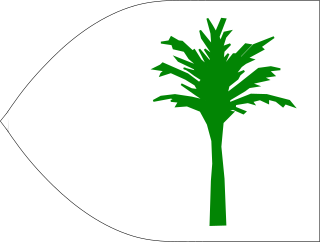Related Research Articles

The Almoravid dynasty was an imperial Berber Muslim dynasty centered in the territory of present-day Morocco. It established an empire in the 11th century that stretched over the western Maghreb and Al-Andalus, starting in the 1050s and lasting until its fall to the Almohads in 1147. The Almoravid capital was Marrakesh, a city founded by the Almoravid leader Abu Bakr ibn Umar circa 1070. The dynasty emerged from a coalition of the Lamtuna, Godala and Massufa, nomadic Berber tribes living in what is now Mauritania and the Western Sahara, traversing the territory between the Draa, the Niger, and the Senegal rivers.

The history of Islam concerns the political, social, economic, military, and cultural developments of the Islamic civilization. Most historians believe that Islam originated in Mecca and Medina at the start of the 7th century CE. Muslims regard Islam as a return to the original faith of the Abrahamic prophets, such as Adam, Noah, Abraham, Moses, David, Solomon, and Jesus, with the submission (Islām) to the will of God.

The Kanem–Bornu Empire existed in areas which are now part of Niger, Cameroon, Central African Republic, Chad, and Nigeria. It was known to the Arabian geographers as the Kanem Empire from the 8th century AD onward and lasted as the independent kingdom of Bornu until 1900.

Mustafa I, called Mustafa the Saint during his second reign and often called Mustafa the Mad by historians, was the son of Sultan Mehmed III and Halime Sultan. He was the Sultan of the Ottoman Empire from 22 November 1617 to 26 February 1618 and from 20 May 1622 to 10 September 1623.

The Umayyad Caliphate was the second of the four major caliphates established after the death of Muhammad. The caliphate was ruled by the Umayyad dynasty. Uthman ibn Affan, the third of the Rashidun caliphs, was also a member of the clan. The family established dynastic, hereditary rule with Muawiya ibn Abi Sufyan, long-time governor of Greater Syria, who became the sixth caliph after the end of the First Fitna in 661. After Mu'awiyah's death in 680, conflicts over the succession resulted in the Second Fitna, and power eventually fell into the hands of Marwan I from another branch of the clan. Greater Syria remained the Umayyads' main power base thereafter, with Damascus serving as their capital.

Uthman ibn Affan, also spelled by the Turkish and Persian rendering Osman, was a second cousin, son-in-law and notable companion of the Islamic prophet Muhammad, as well as the third of the Rāshidun, or "Rightly Guided Caliphs". Born into a prominent Meccan clan, Banu Umayya of the Quraysh tribe, he played a major role in early Islamic history, and is known for having ordered the compilation of the standard version of the Quran. When Caliph Umar ibn al-Khattab died in office aged 60/61 years, Uthman, aged 68–71 years, succeeded him and was the oldest to rule as Caliph.

ʿUmar ibn al-Khaṭṭāb was the second Rashidun caliph, ruling from August 634 until his assassination in 644. He succeeded Abu Bakr as the second caliph of the Rashidun Caliphate on 23 August 634. Umar was a senior companion and father-in-law of the Islamic prophet Muhammad. He was also an expert Muslim jurist known for his pious and just nature, which earned him the epithet al-Fārūq.
Mu'awiya I was the founder and first caliph of the Umayyad Caliphate, ruling from 661 until his death. He became caliph less than thirty years after the death of the Islamic prophet Muhammad and immediately after the four Rashidun ('rightly-guided') caliphs. Unlike his predecessors, who had been close, early companions of Muhammad, Mu'awiya was a relatively late follower of the Islamic prophet.

The Rashidun Caliphs, often simply called the Rashidun, are the first four caliphs who led the Muslim community following the death of the Islamic prophet Muhammad: Abu Bakr, Umar, Uthman, and Ali.

Hisham ibn Abd al-Malik was the tenth Umayyad caliph, ruling from 724 until his death in 743.

The Songhai Empire was a state that dominated the western Sahel/Sudan in the 15th and 16th century. At its peak, it was one of the largest states in African history. The state is known by its historiographical name, derived from its leading ethnic group and ruling elite, the Songhai. Sonni Ali established Gao as the capital of the empire although a Songhai state had existed in and around Gao since the 11th century. Other important cities in the empire were Timbuktu and Djenné, conquered in 1468 and 1475 respectively, where urban-centered trade flourished and to the south is the north Akan state of Bonoman. Initially, the empire was ruled by the Sonni dynasty, but it was later replaced by the Askia dynasty (1493–1901).

A caliphate or khilāfah is an Islamic state under the leadership of an Islamic steward with the title of caliph, a person considered a political-religious successor to the Islamic prophet Muhammad and a leader of the entire Muslim world (ummah). Historically, the caliphates were polities based on Islam which developed into multi-ethnic trans-national empires. During the medieval period, three major caliphates succeeded each other: the Rashidun Caliphate (632–661), the Umayyad Caliphate (661–750), and the Abbasid Caliphate (750–1258). In the fourth major caliphate, the Ottoman Caliphate, the rulers of the Ottoman Empire claimed caliphal authority from 1517. Throughout the history of Islam, a few other Muslim states, almost all hereditary monarchies such as the Mamluk Sultanate (Cairo) and Ayyubid Caliphate, have claimed to be caliphates.

The Hafsids were a Sunni Muslim dynasty of Berber descent who ruled Ifriqiya from 1229 to 1574.

Hadji Oumarûl Foutiyou Tall, , born in Futa Tooro, present day Senegal, was a West African political leader, Islamic scholar, Tijani Sufi and Toucouleur military commander who founded the short-lived Toucouleur Empire encompassing much of what is now Senegal, Guinea, Mauritania and Mali.

The Idrisid dynasty or Idrisids were an Arab Muslim dynasty from 788 to 974, ruling most of present-day Morocco and parts of present-day western Algeria. Named after the founder, Idris I, the Idrisids were an Alid and Hasanid dynasty, descended from Muhammad. The Idrisids are traditionally considered to be the founders of the first Moroccan Muslim state, setting the stage for subsequent dynasties and states centered in this region. Their reign played an important role in the early Islamization of Morocco and also presided over an increase in Arab immigration and Arabization in major urban centers.
The Walashma dynasty was a medieval Muslim dynasty of the Horn of Africa. Founded in 1285, it was centered in Zeila, and established bases around the Horn of Africa. It governed the Ifat and Adal Sultanates in what are present-day Somaliland, Djibouti and eastern Ethiopia.
ʿUmar Dīn, reigned 1526–1553, was a sultan ruling over the Sultanate of Adal in the Horn of Africa. He was the younger brother of Abu Bakr ibn Muhammad.

The Rashidun Caliphate was the first caliphate to succeed the Islamic prophet Muhammad. It was ruled by the first four successive caliphs of Muhammad after his death in 632 CE. During its existence, the empire was the most powerful economic, cultural, and military force in West Asia.

Ali Babba bin Bello was the fourth Sultan of the Sokoto Caliphate from 1842 to 1859. The Sokoto Caliphate leaders are partly Arabs and partly Fulani as stated by Abdullahi dan Fodio, brother of Usman dan Fodio who claimed that their family are part Fulani, and part Arabs, they claimed to descent from the Arabs through Uqba ibn Nafi who was an Arab Muslim of the Umayyad branch of the Quraysh, and hence, a member of the family of the Prophet, Uqba ibn Nafi allegedly married a Fulani woman called Bajjumangbu through which the Torodbe family of Usman dan Fodio descended. Caliph Muhammed Bello writing in his book Infaq al-Mansur claimed descent from Prophet Muhammad through his paternal grandmother's lineage called Hawwa, Alhaji Muhammadu Junaidu, Wazirin Sokoto, a scholar of Fulani history, restated the claims of Shaykh Abdullahi bin Fodio in respect of the Danfodio family been part Arabs and part Fulani, while Ahmadu Bello in his autobiography written after independence replicated Caliph's Muhammadu Bello claim of descent from the Arabs through Usman Danfodio's mother, the historical account indicates that the family of Shehu dan Fodio are partly Arabs and partly Fulani who culturally assimilated with the Hausas and can be described as Hausa-Fulani Arabs. Prior to the beginning of the 1804 Jihad the category Fulani was not important for the Torankawa (Torodbe), their literature reveals the ambivalence they had defining Torodbe-Fulani relationships. They adopted the language of the Fulbe and much ethos while maintaining a separate identity. The Toronkawa clan at first recruited members from all levels of Sūdānī society, particularly the poorer people. Toronkawa clerics included people whose origin was Fula, Wolof, Mande, Hausa and Berber. However, they spoke the Fula language, married into Fulbe families, and became the Fulbe scholarly caste. Ali bin Bello is known by a variety of different names in different sources, including: Ali bin Bello, Aliyu Babba, and Mai Cinaka.
The Askiya Dynasty, also known as the Askia Dynasty, ruled the Songhai Empire at the height of that state's power. It was founded in 1493 by Askia Mohammad I, a general of the Songhai Empire who usurped the Sonni Dynasty. The Askiya ruled from Gao over the vast Songhai Empire until its defeat by a Moroccan invasion force in 1591. After the defeat, the dynasty moved south back to its homeland and created several smaller kingdoms in what is today Songhai in south-western Niger and further south in the Dendi.
References
- H. J. Fisher. "The Sahara and the Central Sudan" in The Cambridge History of Africa: From c.1600 to c.1790. Richard Gray, J. D. Fage, Roland Anthony Oliver, eds. Cambridge University Press, (1975) ISBN 0-521-20413-5